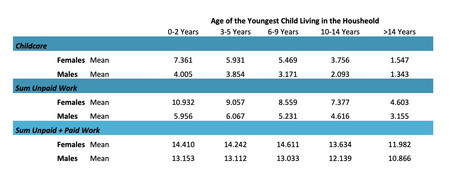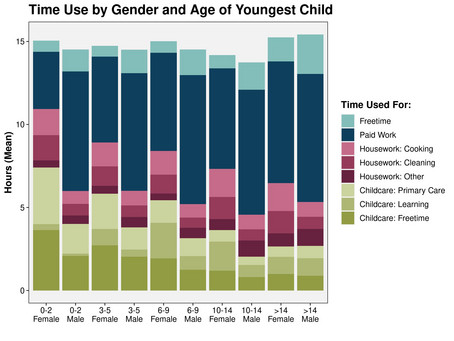#5 Blog: Age of Children and the time use of their Parents during the COVID-19 Lockdown
During the initial and strict COVID-19 restrictions (mid-April to mid-May), women and men worked between 11 and 15 hours per day, both, if paid and unpaid work are added up. In our first blog-post we showed that mothers in couple households worked 14 ¼ hours per day - 9 ½ of those unpaid. Fathers living in couple households worked 13 ¾ hours a day - 7 of which were unpaid. These relations also hold within those couple households where "he", the “breadwinner”, is working full time and "she", as an additional earner, is working part-time: In these households, women worked 13 ¼ hours during the lockdown, 7 ½ unpaid, while men worked 13 hours, of which 5 were unpaid.
However, in terms of the extent and intensity of unpaid work, care for small children is difficult to compare with home-schooling for kids in elementary school. While smaller children cannot cook for themselves, most teenagers can provide for themselves at times. And the employment biographies, especially of mothers, vary to a large extent due to the age of their child(ren). In this blog-post, we show the differences in time-use by the age of the youngest child living in the households. This perspective reveals differences in time-use between father and mothers, but in particular between mothers with children of different ages.

With an average of 11 hours, mothers of very young children (0-2 years) worked the longest hours per day unpaid. 7 out of these 11 hours were used for childcare, the remainder for other housework, such as cooking or cleaning. This group of mothers, at the same time, works the shortest paid hours, which is - due to maternity leaves - not surprising. Adding up paid and unpaid work, this group of mothers stands out as the group with the second-highest total working time. Fathers of young children (0-2 years) are employed a bit more than 7 hours per working day and spend a little less than 6 hours per day on unpaid work, 4 of those hours on childcare.
In general, the time spent on childcare decreases with the increasing age of the youngest child living in the household, as does the difference in hours spent on childcare between fathers and mothers. The difference between mothers and fathers in the hours spent on childcare for kids between 0-2 years of age stands at 3 hours per day! Mothers whose youngest child is between 3 and 5 years of age, spend 2 hours more on childcare as compared to fathers, and overall, they spent on average 3 more hours on unpaid work. Fathers, on the other hand, work on average 2 hours more for pay than mothers do. This is a familiar picture: unpaid work is done predominantly by women, while men work more paid hours.
At 14 ½ hours, the total workload is highest among mothers of children in primary school age (6 to 9 years). These women are employed for an average of 6 hours and, with 5 ½ hours, they provide only slightly less childcare than mothers of kindergarten children (3-5 years). This reveals the burden of home-schooling. Furthermore, mothers of children aged between 6 and 9 provide 2 ¼ hours more childcare than fathers and spend 1 ¼ hours more on other unpaid work. Fathers of children in this age group, by contrast, spend on average 2 hours longer per day for pay than mothers.
The difference in hours spent on childcare between fathers and mothers is, however, significantly lower for parents whose youngest child is between 10 and 14 years of age. The main reason being the time these parents spend on childcare is significantly lower, as compared to parents of younger children. Mothers of kids in this age group, however, spend 1 ½ more hours on childcare, a little less than 2 ¾ hours of total unpaid work, and 2 ½ hours less on paid work than fathers.
Mothers of children who are older than 14 years spend on average slightly more, and fathers slightly less, than 1 ½ hours on childcare per day. At the same time, these mothers work half an hour less per day for pay as compared to fathers. The extent of paid employment is almost equal amongst parents of children who are older than 14 years. However, the distribution of unpaid work within the household remains to be skewed towards mothers.
Time use and activities
Let us now take a closer look at the activities of parents on an average working day during the lockdown. For this purpose, we focus on couple households with children (excluding single parents, given a lack of sufficient observations) and distinguish between paid work, housework and childcare (and different activities) and leisure time.
Figures 1 reveals that - although the amount of time spent on housework is significantly different between fathers and mothers - it does not vary by the age of the youngest child living in the household. Also, the difference in hours used for leisure activities, is constant across all age groups of the youngest child, except that, for parents whose youngest child is older than 14 years, we can see a clear increase in the leisure time of mothers - but also of fathers. Such that, the difference in times of hours remains. Comments from mothers on the questions, such as “after work, he needs free time from his child - I’ve never had that, even if he was at work for 12 hours” or “only the father has the right to a break” highlight the difference in the time available for personal use and recovery between mothers and fathers.

Figure 1 also highlights the relations between the labour force participation and the number of hours spent on paid work and the age of the youngest child. While both increase with the age of the youngest child, the number of hours worked for pay by fathers is constant across all age groups.
Our data also reveal the responsibility of mothers for learning, in particular home-schooling for kids between 6 and 14 years of age, while the responsibility for spending leisure time with the kids is - not equally - but more equally distributed between fathers and mothers. This is highlighted by qualitative responses given by mothers of kinds in school-age, such as “I have the feeling that I do everything on my own.”
